The New Energy and Industrial Technology Development Organization (NEDO) and the Transport Department, Government of NCT of Delhi in India have been carrying out a demonstration project, which is called International Demonstration Project on Japan’s Energy Efficiency Technologies, on an IT operation support system (hereinafter called “the IT system”) for e-mobility (electric vehicles) with the aim of improving passenger’s convenience and transportation efficiency in the section from the nearest station to the destination or from a point of departure to the nearest station (hereinafter called ” last mile transportation”). As part of it, Panasonic Holdings Corporation (Panasonic HD), a subsidized company for the project, and ETO Motors Private Limited (ETO Motors), a local cooperating company, have jointly completed introduction of the IT system and started demonstration operation in October.
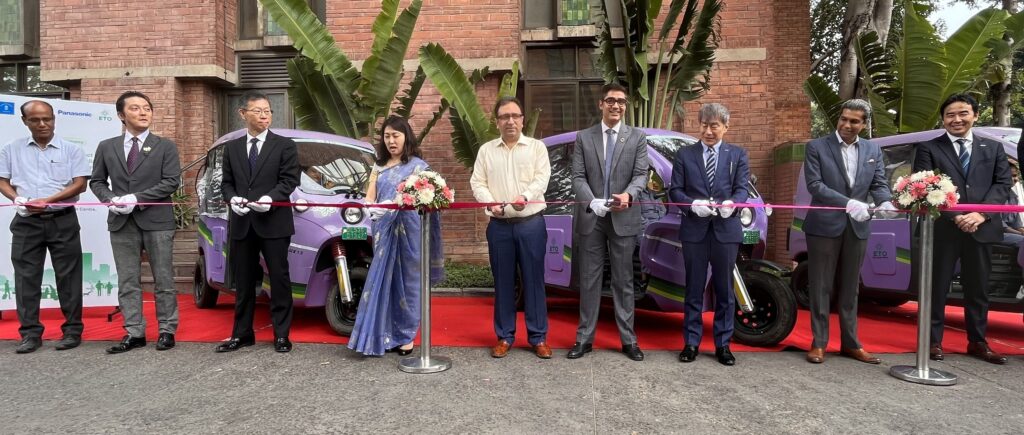
The demonstration operation is to verify enhancement of both passenger’s convenience and transportation efficiency by introducing and operating the IT system for the e-mobility between departure points or destination points and Kalkaji Mandir Delhi metro station in addition to three other nearby stations (Okhla NSIC, Nehru Enclave and Nehru Place). And the project aims to increase the number of e-mobility and Delhi metro users for last mile transportation through the implementation of its outcome, and to improve traffic congestion and reducing greenhouse gas (hereinafter called “GHG”) emissions.
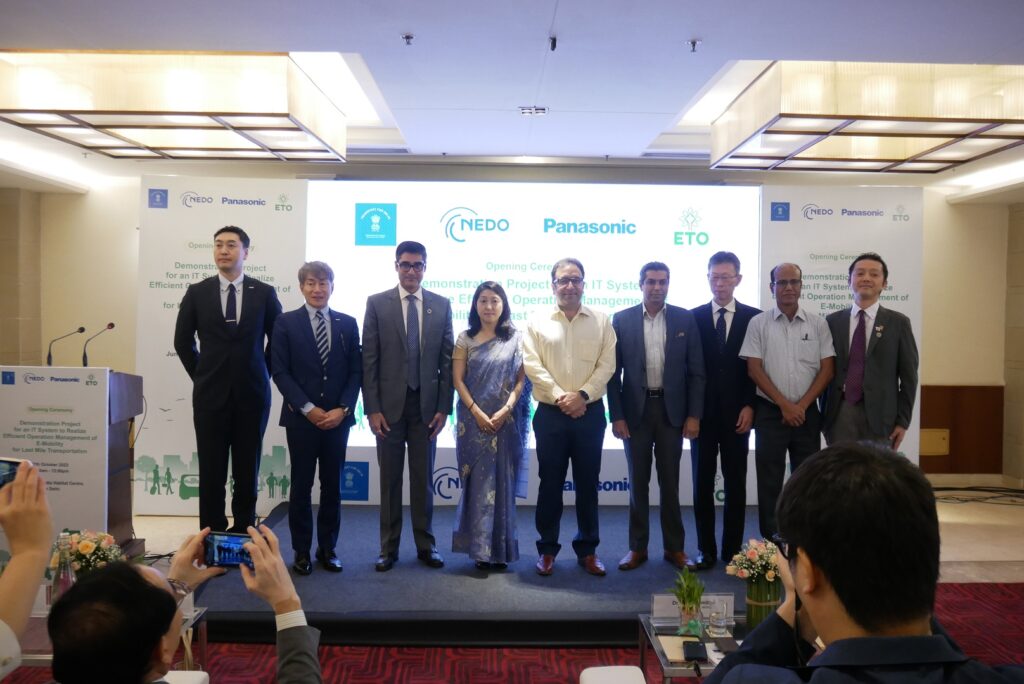
To mark the start of the demonstration operation, an opening ceremony was held recently at the Convention Centre in Delhi, and all parties concerned attended from both India and Japan.
1. Background
Traffic congestion and air pollution caused by it have become serious social problems in India especially in urban areas, due to its rapid economic growth. To solve these problems, policies to promote the wide use of e-mobility*1 which has low environmental load and expansion of the metro network are being implemented. Furthermore, to promote the use of public transport such as the metro system, it is important to concurrently develop last mile*2 transportation.
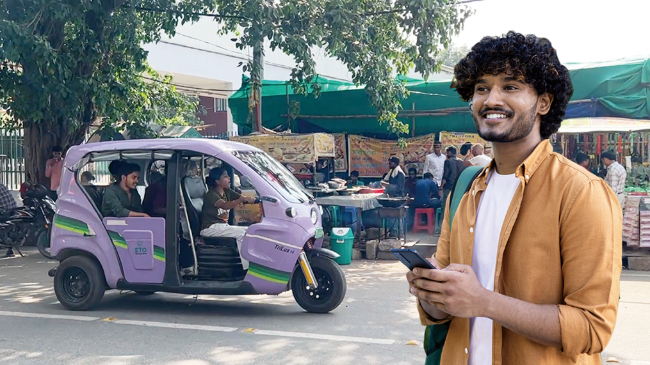
However, the current last mile transportation, such as “auto-rickshaws” of three-wheeled vehicles running on natural gas and the e-mobility is still lacking in convenience and reliability. Thus, local residents tend to use their own cars, taxis, or ride-sharing service, etc. to directly move from the riding point to the destination rather than to fully utilize last mile transportation. It has allowed the traffic volume to significantly increase and rendered the congestion and air pollution much serious, leading to a downward spiral, in comparison with the cases that use public transportation and last mile transportation.
2. Overview of the demonstration project
Under these circumstances, NEDO and the Transport Department, Government of NCT of Delhi in India exchanged letters of Intent (LOI) in December 2022 to carry out a demonstration project, which is called International Demonstration Project on Japan’s Energy Efficiency Technologies*3, on the IT system for e-mobility with the aim of improving passenger’s convenience and transportation efficiency in last mile transportation. Afterwards Panasonic HD, a subsidized company that is responsible for implementing the project, and ETO Motors, a local cooperating company that manufactures and operates e-mobility vehicles, have concluded a project agreement (PA).
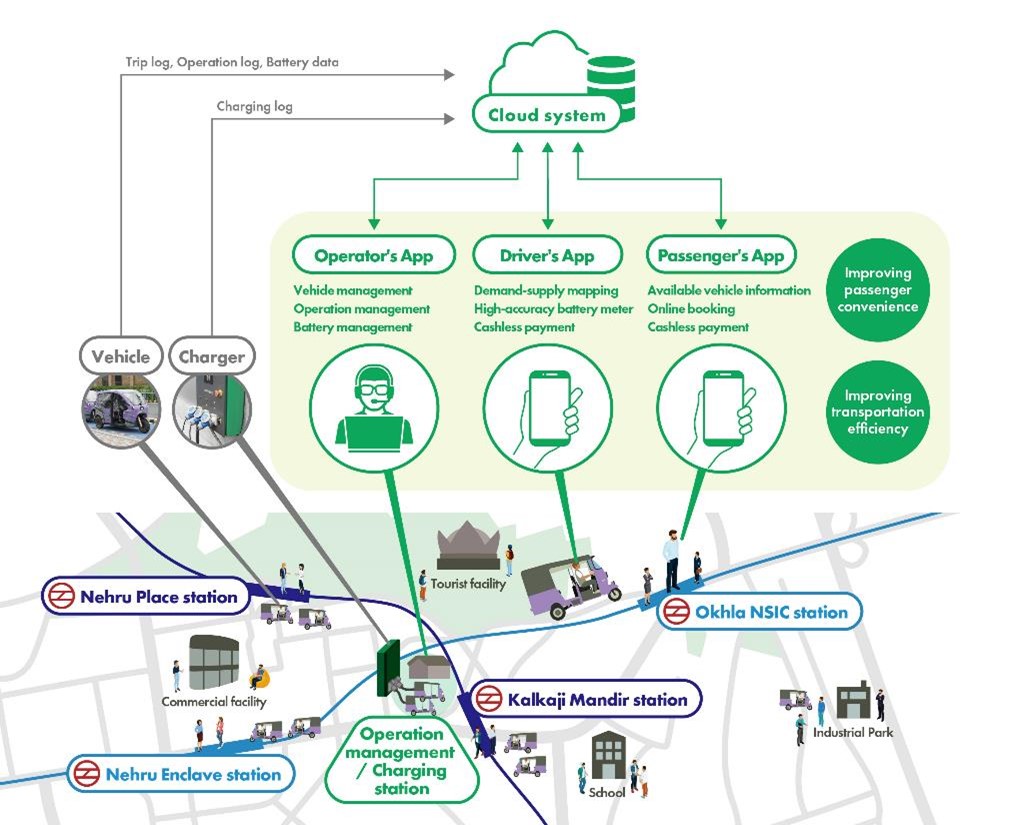
Subsequently, Panasonic HD and ETO Motors launched*4 a demonstration project last year utilizing the IT system for e-mobility in last mile transportation in the areas around the Kalkaji Mandir metro station. An object of the demonstration operation is e-mobility connecting departure points or destination points and Kalkaji Mandir metro station, including three other nearby stations (Okhla NSIC, Nehru Enclave and Nehru Place). The project aims to enhance both passenger’s convenience and transportation efficiency to increase the number of e-mobility and Delhi metro users by introducing and operating the IT system so it should result in improving traffic congestion and reducing GHG emissions.
The IT system introduced in the project is a cloud system that includes functions of on-demand service management, vehicle arrangement algorithms and battery management. The cloud system loads the authentication and information (charging log) to use the e-mobility charger and the information on e-mobility vehicle/operation such as trip log, operation log and battery data via mobile communication. And it also provides the following functions via three apps for operators (vehicle service operators), drivers and passengers respectively (see Fig.1).
- Operator app: Vehicle management / operation, battery management
- Driver app: Demand-supply mapping, display of remaining battery capacity information
with high-precision, cashless settlement
- User app: Vehicle availability information, vehicle reservation,
cashless payment
Panasonic HD has been collecting basic data on passenger services (e.g. e-mobility operating status, time and amount of charging etc.) for last mile transportation utilizing e-mobility while actually setting up the IT system in parallel.
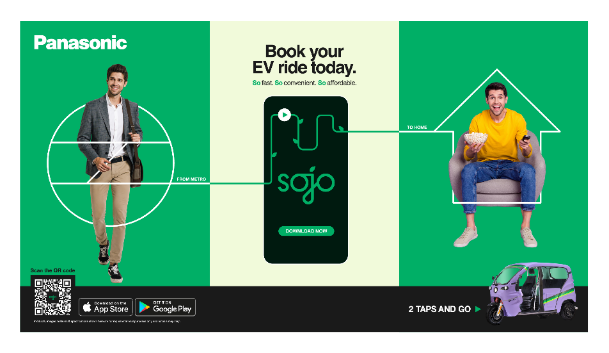
To collect baseline data prior to the introduction of the IT system, Panasonic HD had first created a service environment together with ETO Motors, as well as operationally managed e-mobility and placed charging stations, and then gradually rolled out passenger services since May 2023. At that time, drivers manually recorded e-mobility operation data on papers, such as the number of passengers, trip distance and time, in addition to the time and amount of charging, which was later compiled by the operators as basic data.
Meanwhile, regarding the construction of the IT system, Panasonic HD has been customizing the respective functions of above-mentioned three apps which are the fundamentals of this system, and deleting unnecessary functions and adding new ones, while conducting trial test runs to adjust and improve the coordination between the applications.
3. Future plans
The demonstration operation will verify the expected effects such as increase in passenger numbers, improved operational efficiency (increase in vehicle operating time, decrease in time to destination) and reduction in operation cost (decrease in manpower of operators, increase in battery usage time) are verified by comparing the data collected during the demonstration operation with the baseline data collected before the system was introduced and will also improve and optimize the IT system to further enhance its effectiveness.
As a result of the project, an increase in drivers’ earnings is expected by enhancing both passenger’s convenience and transportation efficiency in last mile transportation. The project also aims to improve traffic congestion, air pollution, and reduce GHG emissions*5 by stimulating the usage of e-mobility and Delhi Metro for last mile transportation.
4. Opening ceremony to mark the start of the demonstration operation
An opening ceremony was held today at the Delhi Convention Centre to mark the start of the demonstration operation of the IT system for e-mobility in the presence of a large number of parties concerned. The ceremony included speeches by several participants. Panasonic HD and ETO Motors presented an overview of the project and the benefits expected from the implementation of the IT system.